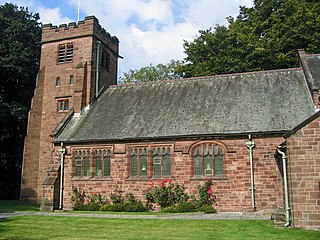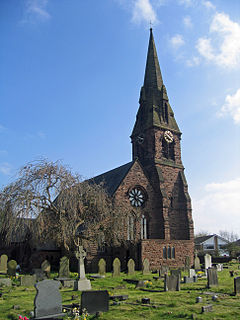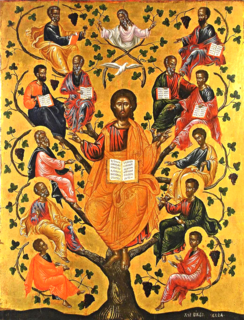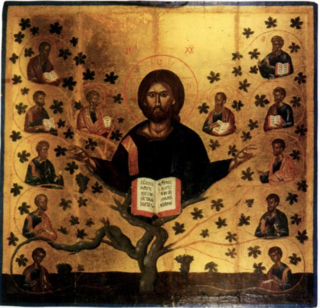Related Research Articles

Luke the Evangelist is one of the Four Evangelists—the four traditionally ascribed authors of the canonical gospels. The Early Church Fathers ascribed to him authorship of both the Gospel of Luke and the Acts of the Apostles, which would mean Luke contributed over a quarter of the text of the New Testament, more than any other author. Prominent figures in early Christianity such as Jerome and Eusebius later reaffirmed his authorship, although a lack of conclusive evidence as to the identity of the author of the works has led to discussion in scholarly circles, both secular and religious.

Santa Maria Novella is a church in Florence, Italy, situated opposite, and lending its name to, the city's main railway station. Chronologically, it is the first great basilica in Florence, and is the city's principal Dominican church.

CarloDolci was an Italian painter of the Baroque period, active mainly in Florence, known for highly finished religious pictures, often repeated in many versions.
Carlo Bononi was an Italian painter.

Claude Vignon was a French painter, printmaker and illustrator who worked in a wide range of genres. During a period of study in Italy, he became exposed to many new artistic currents, in particular through the works of Caravaggio and his followers, Guercino, Guido Reni and Annibale Caracci. A prolific artist, his work has remained enigmatic, contradictory and hard to define within a single term or style. His mature works are vibrantly coloured, splendidly lit and often extremely expressive. Vignon worked in a fluent technique, resulting in an almost electric brushwork. He particularly excelled in the rendering of textiles, gold and precious stones.
Andrea Barbiani (1708–1779) was an Italian painter of the 18th century, mainly active in Ravenna and Rimini. He painted in the style of Cesare Pronti. He was the nephew of the painter Giovanni Battista Barbiani.

The Master of the Morrison Triptych is the name given to an unknown Early Netherlandish painter active in Antwerp around 1500-1510. He is named for the Morrison Triptych, now in Toledo, Ohio, United States, which is described below.

St John the Evangelist's Church is in the village of Sandiway, Cheshire, England. It is an active Anglican parish church of Sandiway and Cuddington in the diocese of Chester, the archdeaconry of Chester and the deanery of Middlewich. The church is recorded in the National Heritage List for England as a designated Grade II listed building.

St John the Evangelist's Church is in Over, Winsford, Cheshire, England. The church is recorded in the National Heritage List for England as a designated Grade II listed building. It is an active Anglican parish church in the diocese of Chester, the archdeaconry of Chester and the deanery of Middlewich.

The Barbadori Chapel, later Capponi Chapel, is a chapel in the church of Santa Felicita in Florence, central Italy. It was designed by Filippo Brunelleschi, and was later decorated by a cycle of works by the Mannerist painter Pontormo.

The Delivery of the Keys, or Christ Giving the Keys to St. Peter is a fresco by the Italian Renaissance painter Pietro Perugino which was produced in 1481–1482 and is located in the Sistine Chapel, Rome.

Triptych of the Sedano family is an oil-on-panel triptych altarpiece by the Early Netherlandish painter Gerard David, usually dated between 1490 and 1498, probably c. 1495. It is noted for its innovative framing and for its rendering of the decorative oriental carpet seen at Mary's feet.

The Mantegna funerary chapel is one of the chapels of the Basilica of Sant'Andrea, Mantua. It houses the tomb of the painter Mantegna and his last two paintings - Baptism of Christ and Holy Family with St John the Baptist, St Elizabeth and St Zacharias (1504-1506). Its frescoes from 1507 were painted by his sons Ludovico and Francesco and by a young Correggio. The tomb bears a bronze figure of Mantegna by Gianmarco Cavalli.

Vision of the Apocalypse also known as The Revelation of John the Evangelist is a tempera painting by Thomas Bathas. The massive icon is over four hundred years old. Bathas was from the island of Crete. He was a painter active during the second half of the 16th century. He was active in Heraklion, Venice, and Corfu. He was an important member of the Cretan School. The painting follows the traditional maniera greca. The magnificent icon is on the Greek island of Patmos inside the Cave of the Apocalypse. The mysterious site is believed by Christians to mark the spot where John of Patmos received his visions that he recorded in the Book of Revelation.

The Crucifixion is an egg tempera painting created by Ioannis Moskos. Moskos was a Greek painter originally from Crete. He migrated to Venice. Two other painters named Moskos were active during the same period. Their names were Elias Moskos and Leos Moskos. Leos and Ioannis were both in Venice during the same period. Ioannis was a member of the Late Cretan School. He was active from 1650 to 1721. Forty-four of his paintings survived.

The Crucifixion is a painting created by Georgio Markazini. Markazini was a Greek painter from the island of Crete. He migrated to Venice. He was active during the middle part of the 17th century. Two of the painter's works survived. The crucifixion was a very popular subject among Cretan painters. Andreas Pavias, Emmanuel Lambardos, and Theophanes the Cretan created a similar style crucifixion. The Cretan painters frequently influenced each other.

Christ the Vine also known as the Tree of Christ is a tempera painting by Leos Moskos. Moskos was active from 1620 to 1690. Twenty of his works have survived. He was originally from Rethimno, Crete. He traveled all over the Venetian empire. He worked on the Ionian islands of Cephalonia and Zakynthos. He also worked in Venice. Two other painters with the same last name were active during the same period. They were Elias Moskos and Ioannis Moskos. All three artists painted in the same style. Leos was in Venice around the same period as Ioannis. There is strong evidence that the three were related. Famous Greek painter and historian Panagiotis Doxaras was Leo’s student.

Christ the Vine is an egg tempera painting by Victor. Victor was a Cretan painter active during the 1600s. The painter traveled all over the Venetian empire. He eventually settled in Zakinthos. He is one of the most important painters of the 17th century due to the enormous amount of his existing works. His catalog of art exceeds over ninety-five paintings.
Christ Enthroned is a tempera painting by Emmanuel Tzanes. Tzanes was a Greek painter active for most of the 17th century. His brothers Konstantinos Tzanes and Marinos Tzanes were painters. Marinos was also a famous poet. One hundred thirty works are attributed to Emmanuel. He was a member of the Late Cretan School. Tzanes was originally from Rethymno, Crete. He migrated to Corfu around 1646. He stayed there with his brother Konstantinos Tzanes. Both of them completed works on the island. He finally migrated to Venice in the 1650s. He became the priest of San Giorgio dei Greci.

Christ the Vine is a tempera painting created by Greek painter Angelos. Angelos was active from 1425 to 1457. He was a teacher and protopsaltis. His students included some of the most famous painters of the early Cretan Renaissance. Andreas Pavias and Andreas Ritzos were his students and were heavily influenced by his style. Forty-nine of his works survived. Angelo’s Christ the Vine was one of his most important works.
References
- Bryan, Michael (1889). Walter Armstrong; Robert Edmund Graves (eds.). Dictionary of Painters and Engravers, Biographical and Critical. Vol. II L-Z. London: George Bell and Sons. p. 431.